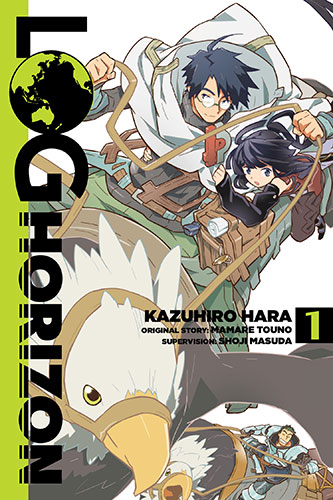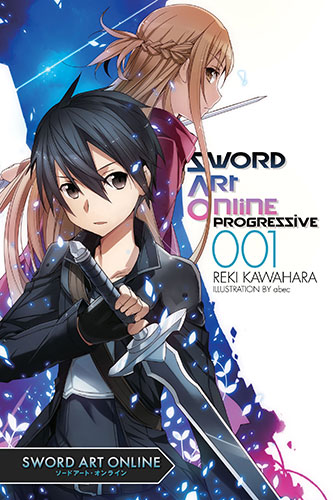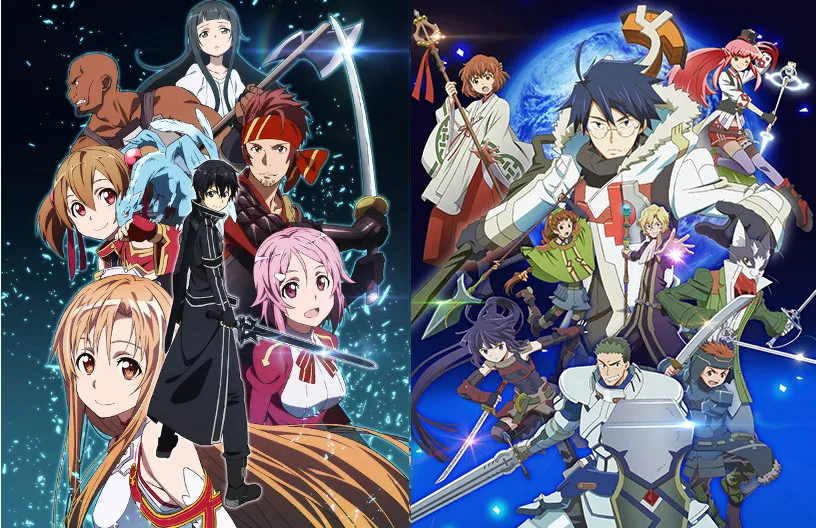So you pull up your game console or log in on your computer and you’re there in another realm. Maybe you’re there alone, intent on battling through the enemies or solving the puzzles on your own. Maybe you’re there with friends—physically next to you on the couch or virtually next to you via the magic of the Internet—and you’re all working together to take on risks and overcome challenges. Whatever the format, whatever your preferred mode of playing, you’re immersed. For the next five minutes or five hours (or five days, no judgment!), your thoughts and actions are focused upon a virtual world built by human hands.
But what if you couldn’t leave that world? What if it was as real, or almost as real, to you as is the one in which you sit right now, reading this?
And that, right there, is the premise of two recent, ongoing cross-media series: Sword Art Online and Log Horizon. Both are based on the premise that thousands of players are suddenly stuck in an online community game, aka MMORPG (“Massively Multiplayer Online Role-Playing Game”), with no way home. No ruby red slippers, no uppity small dog companion—no way over the rainbow. Just stuck.

Sword Art Online (left) vs. Log Horizon (right).
Seeds of Debate
First, a bit about these two series for those unfamiliar with them. Sword Art Online (SAO for short) and Log Horizon have each manifested in multiple ways: light novels, manga, anime, and video games, not to mention toys and other accessories. SAO made a big splash, and I remember seeing it everywhere across the Internet, magazines, and conventions after the anime debuted in the US in 2012. In 2013, the Log Horizon anime hit the scene, and when I saw it I remember thinking, “Um, why do we need another series about players getting stuck in an MMORPG?”
I’m not the only one who thought that, and so the debates began: which is better, SAO or Log Horizon? Obviously, one of them has to definitively come out on top, right? Actually, no. While fans will obviously back their favorite, the commentators I’ve followed (like Chris Sanders and BobSamurai) largely point out that it’s a moot debate. While the basic premise is the same, they’re very different series with very different takes on the subject of being trapped in a video game.
Speaking of which, SAO and Log Horizon are hardly the first to explore themes that blur life, consciousness, and an electronic space. For a similar series arising from Japan, one only has to look back to the .hack franchise from the early 2000s. That’s not all, though. If we’re talking about games specifically, what about Lewis Carroll’s 1871 novel Through the Looking Glass, in which the protagonist wanders into an abstracted chess game? Bring that forward to movies like Tron, The Matrix, and Stay Alive or novels such as Neal Stephenson’s 1992 book Snow Crash, William Gibson’s Neuromancer, or Ready Player One by Ernest Cline, all of which involve melding life and cyberspace.
I knew I couldn’t possibly be thinking of everything, so I asked my friends on Facebook for more examples of being trapped in a video game or virtual space. In what turned into a predictably long conversation thread, they tossed out a huge range of media that touch on the subject. Check it out: Philip K. Dick’s We Can Remember it For You Wholesale (which became the movie Total Recall); the 1983 movie Videodrome; No Game No Life by Yuu Kamiya; Gantz by Hiroya Oku; Mamoru Hosoda’s Summer Wars; Wreck-It Ralph from Disney; the “Take On Me” music video by a-ha; 2014 movie Transcendence; multiple episodes of Star Trek: The Next Generation in which one or the other crew member is trapped on the holodeck; 1998 series Serial Experiments Lain directed by Ryūtarō Nakamura; and many, many more.
Log Horizon and Sword Art Online are simply two (in this case competing) contributions to an ongoing exploration of the increasingly blurry boundaries of life, wobbling between the physical and virtual realms, between body and consciousness.

The Players and Their Stages
Before jumping into an analysis, let’s set the stage, shall we?
Sword Art Online began in 2002 as author Reki Kawahara’s (unsubmitted) entry for the Dengeki Game Novel Prize. Instead, Kawahara self-published the novel on the web and continued working on the series. In 2009, SAO was finally published as a light novel series illustrated by abec. The first series, subtitled Aincrad, follows ace MMORPG gamer Kirito into a new virtual reality game called “Sword Art Online” set in a massive, multi-layer dungeon called Aincrad. Kirito and thousands of other players log into the game on launch day using the NerveGear, a helmet that fits over the users head, interrupting the brain’s signals to the body and translating that into virtual actions instead of physical ones.
Unfortunately for Kirito and the other players, they discover that they cannot log out. Soon after, they’re all instantaneously transported to a central location where a huge, Death-like specter identifies itself as the game’s apparently psychotic creator, Akihiko Kayaba. Kayaba then horrifyingly reverts the players to their real-life genders and features and says, “When your hit points dwindle to zero, your avatar will be permanently deleted… and the NerveGear will destroy your brain.” [1] There is one very small pinprick of hope, though: to escape Aincrad, someone must defeat the final boss on the hundredth floor of the dungeon. Thus begins Kirito’s adventure. Along the way, he meets and falls in love with the lovely, talented, fierce newbie player Asuna, and together they forge their way toward the heights of the dungeon.
After Aincrad, Kirito’s story continues in a number of other arcs and spin-offs that delve deeper into Aincrad and explore other virtual realms. Of these, Fairy Dance, Progressive and Girls’ Ops (light novels and manga) have been published in the US by Yen Press. Seasons 1 and 2 of the “Sword Art Online” anime, which covers multiple volumes of the light novel, are available on many platforms. Lastly, you’ll find SAO games for various Playstation platforms. Quite the empire, eh?
Log Horizon, much like SAO, also began as an online serial. Writer Mamare Touno began the project in 2010, and the light novel, including illustrations by Kazuhiro Hara, was first published in Japan in 2011. The first volume of the manga followed shortly thereafter, as did an anime adaptation and game. Not quite as expansive as SAO, but the series’ success is nothing to sneeze at.

Log Horizon follows Shiroe, a longtime player of the MMORPG “Elder Tales,” and his community within the game. When “Elder Tales” releases an update, Shiroe logs in to the game on his computer only to find himself physically there—at least, as far as he can tell. Shiroe and the other players who became trapped within the game have retained all of their character stats and items as well as their appearances (cat people are still cat people, for instance). In sharp contrast with SAO, if players are killed in the “Elder Tales” world, they simply reincarnate at the nearest temple. The focus of the story, then, is not on life or death risk, it’s on daily life within an entirely new world that just happens to act like a video game.
Shiroe is a loner; rather than affiliate with a guild, he likes to party with a freewheeling group of friends called the Debauchery Tea Party. That was several years back, though, and he hasn’t been playing much since life got in the way of gaming for a number of the group’s members. In this new situation, though, Shiroe comes to realize that someone needs to take hold of the reins of society because things are getting rough pretty quick. So what does he do? He forms his own guild, Log Horizon, and works with other guilds to basically manipulate everyone else into forming a government they dub the Round Table.
As the series progresses, the importance of the Non Player Characters (NPCs) gradually increases. The players—called Adventurers as a group—realize that the NPCs are much more complex than previously. In fact, they seem to be living beings rather than AI constructs. They have their own kingdoms and alliances, and the Adventurers of the Round Table find themselves in the thick of sensitive political situations not of their own making.
Once order is established, Shiroe begins to explore his new world, trying to figure out exactly what happened to land them all there. However, for everyone else, getting home seems almost secondary to establishing a way of life in the “Elder Tales” world. This, in and of itself, shows that Log Horizon and Sword Art Online are completely different beasts. Although SAO does spend some time on everyday life within Aincrad, it’s more to show how Kirito and Asuna fall in love than for its own sake. Where Log Horizon focuses on community, SAO revolves around Kirito’s lone journey—even though he falls in love with Asuna, she’s not the subject, she’s the object.
 Gadfly of Unhelpful Media probably sums it up the best when he says that the difference between the two series is like the difference between third and first person when you’re reading a story. Which, actually, is exactly the case: Log Horizon is told in the third person, and the SAO novels are first person narratives from Kirito’s perspective (with some chapter-long, third person omniscient exceptions). Furthermore, in SAO Kirito’s development is clear, and the other characters develop around him. In Log Horizon, a wide variety of characters are given their own side adventures and lines of development. It’s an individual focus versus a community focus.
Gadfly of Unhelpful Media probably sums it up the best when he says that the difference between the two series is like the difference between third and first person when you’re reading a story. Which, actually, is exactly the case: Log Horizon is told in the third person, and the SAO novels are first person narratives from Kirito’s perspective (with some chapter-long, third person omniscient exceptions). Furthermore, in SAO Kirito’s development is clear, and the other characters develop around him. In Log Horizon, a wide variety of characters are given their own side adventures and lines of development. It’s an individual focus versus a community focus.
Later SAO releases, such as the Sword Art Online Progressive light novels, seem to be an attempt to remedy that somewhat. SAO’s Aincrad arc skips months at a time to focus on pivotal moments; Progressive tells the story of Aincrad again, but does so at a slower pace. Asuna gets more time to her own development and the motivations of other characters are shown a bit more clearly. In fact, in Progressive 002, we even meet an NPC who doesn’t behave exactly like Kirito expects an NPC to behave. That being said, the story is still primarily Kirito’s, and SAO remains in contrast to Log Horizon’s take on being trapped in a video game.
Utopia/Dystopia
What is the purpose of video games and of online community games? Many things, surely, and different things for different people. They’re contests of wit and coordination; they’re escapes, distraction from everyday life; they’re engaging stories; they’re spaces of friendship and community; they’re records of achievement; and they’re fun.
Hanna Sommerseth contends, “With regards to video games, this focus on cyberspace as a radically ‘other’ realm has resulted in a situation in which games are frequently considered within the framework of either utopian or dystopian thinking. On the one hand, games may be seen as spaces where a player can be anything, do anything, and if not play God then at least play with the notion of self. On the other hand, games are regularly … considered a dangerous and soul-destroying activity …” [2]
While many games place their players within dystopian or post-apocalyptic settings, there is still an element of power and freedom of choice that, I would argue, hark to a utopian state. Over the course of my 100+ hours of gameplay in “Fallout 3,” I achieved wealth, several stable places to live, and communities of people who admired and appreciated me. I also triumphed over my enemies in a very viscerally satisfying manner. Maybe I got some penalties if I didn’t find food or sleep, but I didn’t actually starve, and what did I care if I died in the game? If I did, I just reloaded the game and tried again, no big deal.
What it comes down to is that when I play video games, I don’t have to worry about the basic necessities of life. I’ve got everything I need already. That sure sounds like a utopia to me.
![In Sword Art Online episode 1, Kirito expresses how he feels about SAO prior to becoming trapped in the game. [Aniplex, retrieved from Crunchyroll]](https://www.themarysue.com/wp-content/uploads/2015/06/Kirito-Sword-Art-Online-Ep-01-Aniplex.jpg?resize=954%2C536)
In Sword Art Online episode 1, Kirito expresses how he feels about SAO prior to becoming trapped in the game. [Aniplex, retrieved from Crunchyroll]
SAO and Log Horizon both explore what happens when a utopia is suddenly turned into a dystopia. Instead of realms of nearly unlimited potential and power, players are plunged right back into worrying about the facts of life: eating, sleeping, getting along with others, finding happiness, and (in SAO’s case) not dying.
In the first volume of the Log Horizon light novel series, Touno writes, “However, Elder Tales had been a game, not a real world. In Elder Tales, there had been no sleep and no pain. This world was not a game … Ever since the day of the Catastrophe, [Shiroe]’d had the uneasy feeling that, the instant he thought of this world as being the Elder Tales world, he’d make some terrible mistake.” [3]
![In Log Horizon episode 6, Nyanta (left) explains to Shiroe (right) that no life is perfect. He goes on to say "Any kind of life can go wrong, or sicken, or suffer." [NHKEnterprise, retrieved from Crunchyroll]](https://www.themarysue.com/wp-content/uploads/2015/06/Nyanta-talks-with-Shiroe-Log-Horizon-episode-6.jpg?resize=954%2C536)
In Log Horizon episode 6, Nyanta (left) explains to Shiroe (right) that no life is perfect. He goes on to say “Any kind of life can go wrong, or sicken, or suffer.” [NHKEnterprise, retrieved from Crunchyroll]
As for which is better, it’s your coin to toss. Which digital life would you rather lead, after all?
![In the SAO Aincrad arc opening sequence, Asuna's "real life self" is mirrored in SAO. [Aniplex; retrieved from Crunchyroll]](https://www.themarysue.com/wp-content/uploads/2015/06/SAO-Opening-Asuna-Aniplex.jpg?resize=954%2C536)
In the SAO Aincrad arc opening sequence, Asuna’s “real life self” is mirrored in SAO. [Aniplex; retrieved from Crunchyroll]
————–
The media:
- Sword Art Online: Aincrad; story by Tamako Nakamura, art by Reki Kawahara, character design by abec; Yen Press, 2014.
- Sword Art Online: Aincrad 001; Reki Kawahara, illustration by abec; Yen Press, 2014.
- Sword Art Online: Aincrad 002; Reki Kawahara, illustration by abec; Yen Press, 2014.
- Sword Art Online: Fairy Dance 001; original story by Reki Kawahara, art by Tsubasa Haduki, character design by abec; Yen Press, 2014.
- Sword Art Online: Progressive 001; Reki Kawahara, illustration by abec; Yen Press, 2015.
- Sword Art Online: Progressive 002; Reki Kawahara, illustration by abec; Yen Press, 2015.
- Sword Art Online: Progressive 001; original story by Reki Kawahara, art by Kiseki Himura, character design by abec; Yen Press, 2015.
- Sword Art Online: Progressive 002; original story by Reki Kawahara, art by Kiseki Himura, character design by abec; Yen Press, 2015.
- Sword Art Online: Girls Ops; original story by Reki Kawahara, art by Kiseki Himura, character design by abec; Yen Press, 2015.
- “Sword Art Online” A-1 Pictures; Aniplex of America. Season 1: 2012; Season 2: 2014.
- Log Horizon volume 1; Kazuhiro Hara, original story by Mamare Touno, supervision by Shoji Masuda; Yen Press, 2015.
- Log Horizon volume 1: The Beginning of Another World; Mamare Touno, illustration by Kazuhiro Hara, original; Yen Press, 2015.
- “Log Horizon” published by NHKEnterprise. Season 1: 2013-2014. Season 2: 2014-2015.
Citations:
[1] Page 47. Nakamura, Tamako and Kawahara, Reki. Sword Art Online: Aincrad. Yen Press, Hachette Book Group. March, 2014.
[2] Page 766. Sommerseth, Hanna. “Gamic realism: Player, perception and action in video game play.” In Proceedings of DiGRA 2007 Conference. 2007.
[3] Page 145. Touno, Mamare. Log Horizon, Volume 1: The Beginning of Another World. Yen Press, Hachette Book Group. April, 2015.
Review copies of manga and light novels were provided by Yen Press.
Amanda M. Vail is a writer, editor, and consumer of as many comics as possible. In addition to running her business, Three Wrens, she’s a staff writer for Women Write About Comics. Follow her musings on Twitter @amandamvail.
—Please make note of The Mary Sue’s general comment policy.—
Do you follow The Mary Sue on Twitter, Facebook, Tumblr, Pinterest, & Google +?









Published: Jun 12, 2015 10:00 am